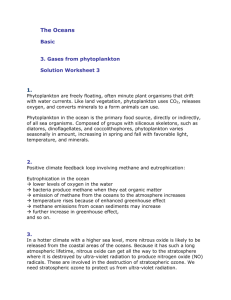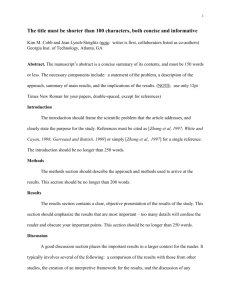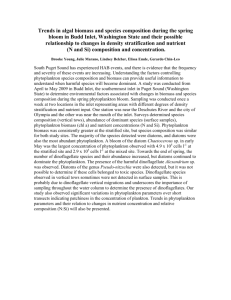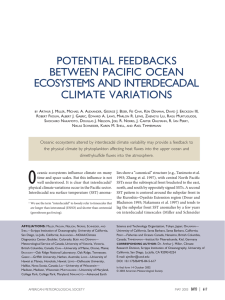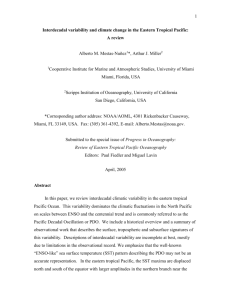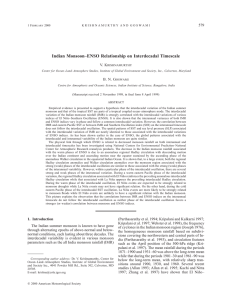chai1
advertisement
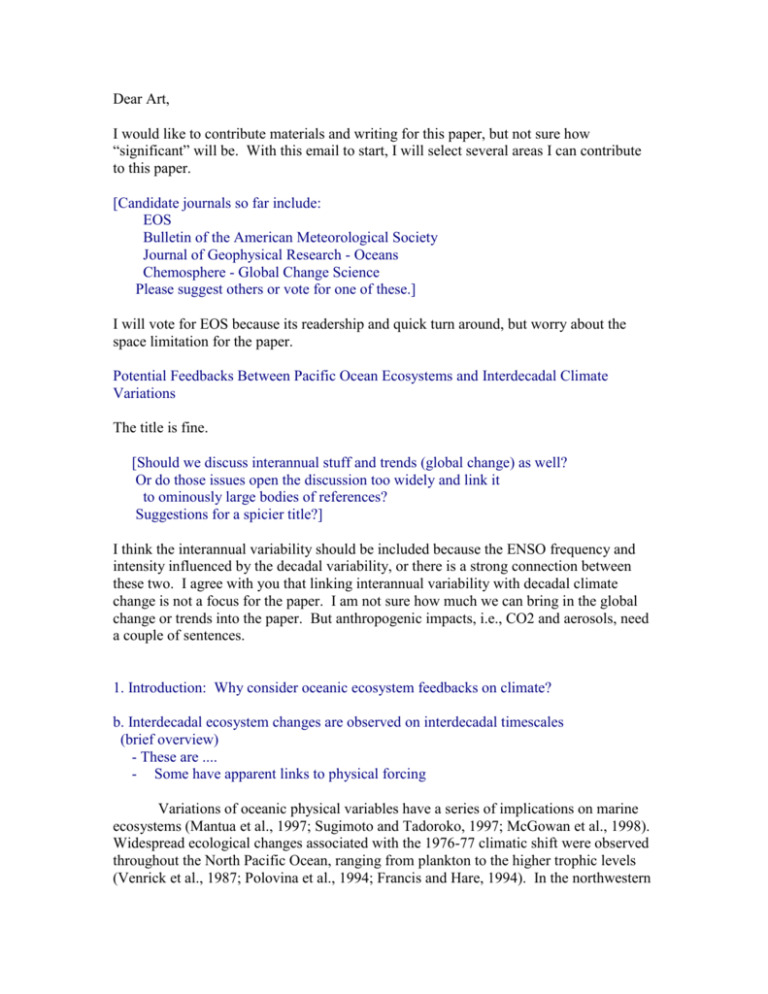
Dear Art, I would like to contribute materials and writing for this paper, but not sure how “significant” will be. With this email to start, I will select several areas I can contribute to this paper. [Candidate journals so far include: EOS Bulletin of the American Meteorological Society Journal of Geophysical Research - Oceans Chemosphere - Global Change Science Please suggest others or vote for one of these.] I will vote for EOS because its readership and quick turn around, but worry about the space limitation for the paper. Potential Feedbacks Between Pacific Ocean Ecosystems and Interdecadal Climate Variations The title is fine. [Should we discuss interannual stuff and trends (global change) as well? Or do those issues open the discussion too widely and link it to ominously large bodies of references? Suggestions for a spicier title?] I think the interannual variability should be included because the ENSO frequency and intensity influenced by the decadal variability, or there is a strong connection between these two. I agree with you that linking interannual variability with decadal climate change is not a focus for the paper. I am not sure how much we can bring in the global change or trends into the paper. But anthropogenic impacts, i.e., CO2 and aerosols, need a couple of sentences. 1. Introduction: Why consider oceanic ecosystem feedbacks on climate? b. Interdecadal ecosystem changes are observed on interdecadal timescales (brief overview) - These are .... - Some have apparent links to physical forcing Variations of oceanic physical variables have a series of implications on marine ecosystems (Mantua et al., 1997; Sugimoto and Tadoroko, 1997; McGowan et al., 1998). Widespread ecological changes associated with the 1976-77 climatic shift were observed throughout the North Pacific Ocean, ranging from plankton to the higher trophic levels (Venrick et al., 1987; Polovina et al., 1994; Francis and Hare, 1994). In the northwestern subtropical gyre region, chlorophyll a in spring showed a steady increase from the mid 1970s to the mid 1980s (Limsakul et al., 2001). Temporal increases of phosphate and apparent oxygen utilization (AOU) in the western subarctic Pacific from 1968 to 1998 have been reported by Ono et al. (2001). Emerson et al. (2001) have reported similar increases in the northeast subtropical Pacific between 1980 and 1997. c. Potential feedback mechanisms (brief overview) - Certain biological feedbacks may sensitize physical system - Biology might affect the spectral characteristics of ocean variability (e.g. through positive or negative feedback) - DMS effects on clouds/radiation/rainfall - Phytoplankton effects on ocean absorption - Nutient cycling changes may modulate the above two mechanisms Nutrient cycling should include the effects of iron. Very recently, I have heard some suggestions about frequency and intensity of Asia dust storms may have some decadal signals, and potentially alter the ocean productivity on the decadal scale. d. Goal of paper: Suggest mechanisms, avenues of research, and required observations of interdecadal bio-climate feedbacks I think that “to promote future truly coupled physical-biological model, and plan the coordinated modeling efforts” should be included in the goal of paper. 2. Scientific Issues b. Current understanding of how physics can alter oceanic ecosystems on interdecadal timescales - Quantify the forced biological response - Relative importance of intrinsic biological variations I can contribute the following figure and text from our modeling work. Please notice that interannual variability of the spring blooms seems stronger after 1975/76. Modeled Spring-time (March-April) Phytoplankton Biomass in the Northwest Pacific (35oN-45oN, 160oE-160oW) The change in the modeled nitrate has impact on the modeled phytoplankton biomass. The figure shows the sprint-time (March-April) vertical integrated (0-60m) total phytoplankton biomass for the North West Pacific (35N-45N, 160E-160W). The modeled total phytoplankton biomass includes both diatoms and small phytoplankton, the diatoms are dominated in the total biomass. In general, the phytoplankton blooms spring blooms are much stronger after 1975/76 comparing to the period before, which consistent with the nitrate conditions in the upper 100m. There is some interannual variability, and it seems the spring blooms are intensified in the northwest Pacific during El Nino years, for example, 1972/73, 1976/76, 1982/83, 1986/87, and 1991/92. The most dominated trend is between the period 1962-75 and 1976-1992, with the spring-time integrated phytoplankton biomass are 27.8 vs. 36 (mmol-N/m2). The changes of phytoplankton biomass in the Northwest Pacific have been documented by many researchers. For example, a two-fold increase in the integrated chlorophyll a was observed during summer (Venrick et al., 1987). In the northwestern subtropical gyre region, chlorophyll a in spring showed a steady increase from the mid 1970s to the mid 1980s (Limsakul et al., 2001). In the subarctic North Pacific, rapid changes in zooplankton abundance (Brodeur & Ware, 1992) and a striking increase in combined salmon catches (Beamish & Bouillon, 1993) were reported. Overall, the modeled physical-biological results seem to support some limited observations in the North Pacific. c. Explain the mechanisms that might allow the biological response to influence interdecadal physical climate variations - Identify what parts of the ecosystem are important - Explain details of upper-ocean absorption, phytoplankton, SST, and clouds - Explain details of DMS fluxes and CCN, clouds, and radiative effects - Explain details of nutrient limiting (Fe, Si, NO3) effects on these processes I can contribute here, but not sure how at this point. I think the role of phosphate needs to discuss, especially on decadal time scale, Karl et al. and Emerson et al. - Quantify, if possible, the amplitude and structure of physical response - Discuss seasonality issues in feedbacks between physics and biology - Discuss why carbon sequestration is not important feedback effect on interdecadal timescales What do you mean by carbon sequestration here? 4. Research Challenges How can these interdecadal biological feedbacks be tested with observations or models? It should be “AND” modeling. a. Research needing to be done [Do we need to rank these in order of importance or feasibility?] i. Climate model sensitivity to DMS forcing by ocean biology ii. Long run of physical-biological coupled climate model - include proper treatment of solar absorption in upper ocean - determine signal to noise ratio of bio-ocean-atm effects to intrinsic atmospheric and ocean-atmospheric variability - successively add sophistications to biology to determine importance of refinements and conditions for importance iii. Intercompare biological models Coordinated modeling efforts, such as annual workshop, and community based model development. iv. Separate greenhouse gas forcing effects from "natural" interdecadal variations I recommended on this one, certainly can contribute to this subject. In order to estimate the anthropogenic CO2 invasion into the ocean, one has to consider variation of the total CO2 concentration caused by the natural variability. In the North Pacific, the TCO2 can vary on the order of 50 umol/kg on interdecadal time scale, and there is a gradually anthropogenic CO2 invasion in the region. Separating these two processes may not be an easy task, and need more attention and research. v. Conceptual models of bio-climate feedbacks - any compelling candidates? vi. Ocean-only forced coupled ocean-biological hindcasts I have done some work on this topic. As in the previous section, I have included a figure to show the intensity of the spring phytoplankton bloom in the North Pacific changed around 1975/76. I can add more to it if you like. Let me know if you need more here. vii. Cloud-mixed-layer-biology model runs - identify atmospheric signal from biologically induced SST anomalies
